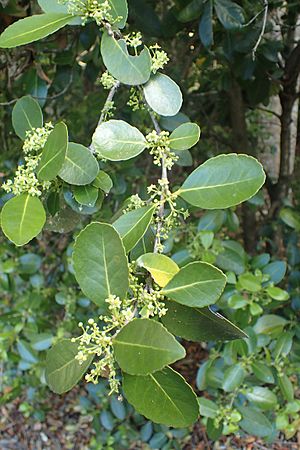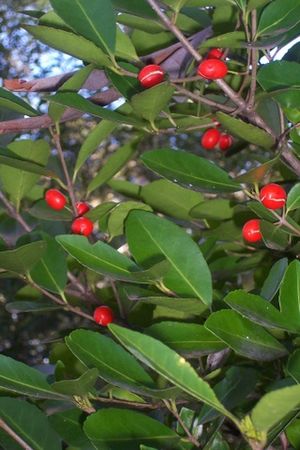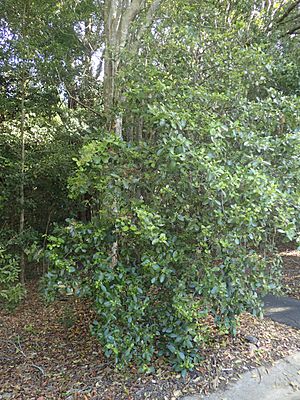Red olive-berry facts for kids
Quick facts for kids Red olive-berry |
|
|---|---|
 |
|
| Leaves and female flowers in Coffs Harbour Botanic Garden | |
| Scientific classification | |
| Genus: |
Elaeodendron
|
| Species: |
australe
|
| Synonyms | |
|
|
The Elaeodendron australe, often called red olive-berry, red-fruited olive plum, or blush boxwood, is a type of flowering plant. It belongs to the Celastraceae family. This plant is endemic to eastern Australia, meaning it grows naturally only in that area. It can be a shrub or a small tree. It has leaves shaped like eggs or oblongs, with wavy edges. Its flowers are yellowish-green, and male and female flowers grow on different plants. The plant also produces fleshy, orange-red fruits.
Contents
What the Red Olive-Berry Looks Like
The red olive-berry is usually a shrub or a small tree. It can grow up to 8 meters (about 26 feet) tall. This plant has separate male and female plants, which means you need both for it to make seeds.
Leaves and Flowers
Most of the leaves grow in pairs opposite each other. They are shaped like eggs, ellipses, or oblongs. Their edges are often wavy. The leaves can be from 2.7 to 15 centimeters (about 1 to 6 inches) long and 0.4 to 7 centimeters (about 0.2 to 2.8 inches) wide. They grow on a small stem called a petiole, which is about 4 to 10 millimeters long.
The yellowish-green flowers grow in small groups called cymes. These groups appear where the leaves meet the stem. Each flower has four petals and is about 4 millimeters long. Male flowers have four stamens, which produce pollen. Female flowers have four staminodes, which are like stamens but do not produce pollen.
Fruit and Flowering Time
The red olive-berry flowers during spring and summer. Its fruit is a fleshy, orange-red drupe. A drupe is a fruit with a hard pit inside, like a peach or a cherry. These fruits are usually oblong to oval and are about 1 to 2.5 centimeters (about 0.4 to 1 inch) long. The fruit ripens from March to July and often stays on the tree for many months.
Where the Red Olive-Berry Grows
Red olive-berry plants grow in areas where eucalypt forests meet rainforests. They also like to grow near the coast in what is called littoral rainforest, or in dry rainforest areas. You can find this plant in north-eastern and central eastern Queensland. It also grows as far south as Tuross Head in New South Wales. There is a special type of this plant with thick leaves that grows in Mount Kaputar National Park and nearby areas.
Growing Red Olive-Berry Plants
If you want to grow a red olive-berry from a seed, it takes a long time for the seed to sprout. However, about 25% of the seeds will successfully grow into plants after about a year.
Images for kids






